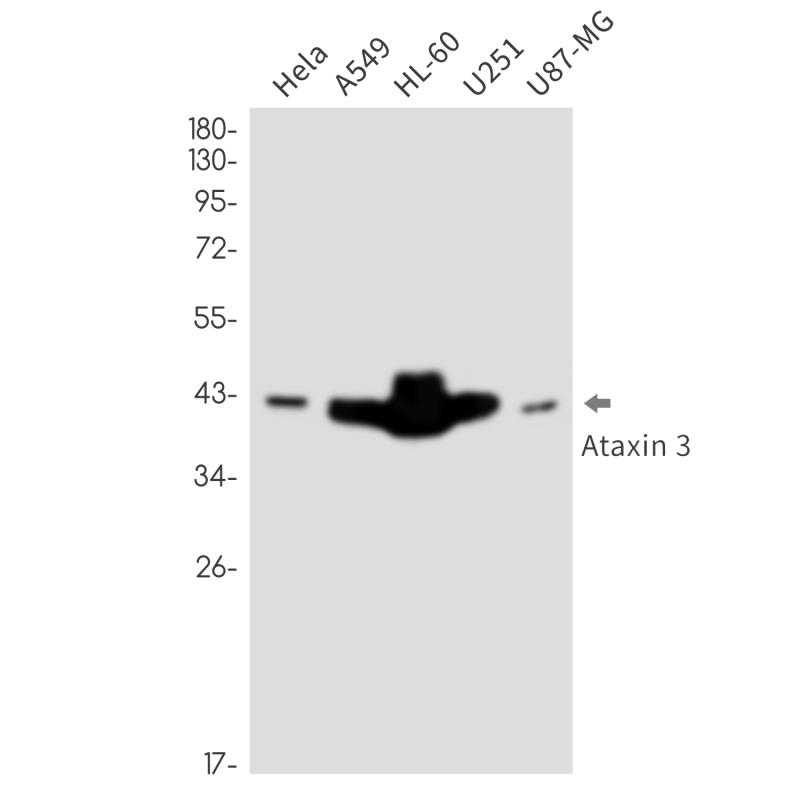
| WB | 1/500-1/1000 | Human,Mouse,Rat |
| IF | 咨询技术 | Human,Mouse,Rat |
| IHC | 咨询技术 | Human,Mouse,Rat |
| ICC | 技术咨询 | Human,Mouse,Rat |
| FCM | 咨询技术 | Human,Mouse,Rat |
| Elisa | 咨询技术 | Human,Mouse,Rat |
| Aliases | AT3; JOS; MJD; ATX3; MJD1; SCA3 |
| Entrez GeneID | 4287 |
| WB Predicted band size | Calculated MW: 41 kDa; Observed MW: 41 kDa |
| Host/Isotype | Rabbit IgG |
| Antibody Type | Primary antibody |
| Storage | Store at 4°C short term. Aliquot and store at -20°C long term. Avoid freeze/thaw cycles. |
| Species Reactivity | Human |
| Immunogen | A synthetic peptide of human Ataxin 3 |
| Formulation | Purified antibody in TBS with 0.05% sodium azide,0.05%BSA and 50% glycerol. |
+ +
以下是关于Ataxin-3抗体的3篇参考文献及其摘要:
---
1. **文献名称**:*Formation of neuronal intranuclear inclusions underlies the neurological dysfunction in mice transgenic for the HD mutation*
**作者**:Paulson, H. L., et al.
**摘要**:该研究利用针对Ataxin-3的抗体,在小鼠模型中揭示了突变Ataxin-3蛋白在神经元核内形成包涵体的过程,并证明这些包涵体与神经功能障碍相关,为脊髓小脑性共济失调3型(SCA3)的病理机制提供了关键证据。
---
2. **文献名称**:*Machado-Joseph disease gene product is a cytoplasmic protein widely expressed in brain*
**作者**:Kawaguchi, Y., et al.
**摘要**:作者通过特异性抗体检测发现,Ataxin-3蛋白(SCA3致病基因产物)广泛表达于大脑细胞质中,其异常聚积与多聚谷氨酰胺(polyQ)扩展突变相关,为后续研究Ataxin-3的生理功能及疾病机制奠定了基础。
---
3. **文献名称**:*Identification of a novel ubiquitin-binding site in the deubiquitinating enzyme ataxin-3*
**作者**:Burnett, B. G., et al.
**摘要**:该研究利用Ataxin-3抗体进行免疫共沉淀实验,发现Ataxin-3通过特定结构域与泛素链结合,揭示了其去泛素化酶活性在调控蛋白质稳态中的作用,为开发靶向Ataxin-3功能的治疗策略提供了依据。
---
这些文献涵盖了Ataxin-3抗体在病理机制、蛋白定位及功能研究中的应用,均为SCA3领域的经典研究。
Ataxin-3 is a ubiquitously expressed deubiquitinating enzyme primarily localized in the nucleus and cytoplasm. It plays a critical role in protein quality control by cleaving ubiquitin chains and regulating proteasomal degradation. The protein is encoded by the ATXN3 gene, and abnormal polyglutamine (polyQ) expansion in its C-terminal region leads to the neurodegenerative disorder Machado-Joseph disease (MJD/SCA3), a type of spinocerebellar ataxia.
Antibodies targeting Ataxin-3 are essential tools in studying its physiological functions and pathological mechanisms. These antibodies are widely used to detect Ataxin-3 expression levels, subcellular localization, and aggregation patterns in cellular and animal models. They help distinguish between the normal (non-expanded) and mutant (polyQ-expanded) forms, which are critical for understanding disease progression. Common applications include Western blotting, immunohistochemistry, immunofluorescence, and co-immunoprecipitation assays.
Research utilizing Ataxin-3 antibodies has advanced insights into its role in protein homeostasis, interactions with chaperones, and involvement in neurodegenerative pathways. Additionally, these antibodies are vital in evaluating therapeutic strategies, such as gene silencing or small-molecule interventions, aimed at reducing toxic polyQ aggregates. Specific monoclonal or polyclonal antibodies are often validated using knockout cell lines or tissues to ensure target specificity. Understanding Ataxin-3's dual role in health and disease continues to drive the development of precise research tools and potential clinical biomarkers.
×